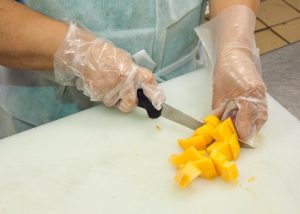1.3.3 Assisting Clients with Food Preparation or Feeding
As a Personal Care Assistant, you will likely assist clients with food items regularly or at least occasionally. All procedures in health care are determined by a review of the best practices for client care. A best practice is a method or technique that has been generally accepted as superior to any alternatives because it has optimal results. In health care, best practices are always informed by rigorous scientific research, with adjustments made as needed according to the unique needs and limitations of your facility or other care delivery environment.
When working with food preparation, the following best practices will help you to keep food free from pathogens that could cause illness:
- Wash your hands, the food (vegetables/fruits), preparation surfaces and utensils with warm soapy water, and rinse well to eliminate the bacteria.
- If the food is pre-packaged, check the date on the food to be sure the sell-by date has not passed. If the food is perishable, use your senses: observe the food for areas of decay and smell the food for any malodor. Wash all vegetables and fruits prior to serving.
- Always separate raw food from cooked foods to avoid cross contamination. Be extra careful with raw meat and fish. Ensure that you wash all utensils, surfaces and your hands immediately after handling these types of foods.
- Always refrigerate leftovers within two hours to reduce the potential bacteria growth.
- If cooking food, heat the item to a safe internal temperature using a food thermometer to be certain the temperature is high enough to kill bacteria.
Key Takeaway
Find additional food safety guidelines that you should take into account when working with seniors and other vulnerable populations from Health Canada.
When assisting clients with feeding, using the following steps will help to be sure you are following due diligence to prevent pathogen transmission while assisting a client to eat:
- Wash your hands.
- Cue the client to wash face and hands.
- Wash the table areas.
- Use only clean eating utensils and plates.
- While assisting with feeding, keep the silverware on the plate/bowl if not being held.
- Do not scrape food into the mouth from surrounding skin; use a napkin to remove the food from the area around the mouth.
- Throw leftover food away in the appropriate receptacle.
- Cue the client to wash their hands and face after the meal.

Media Attributions
- “20111025-FNS-RBN-1967” by USDAgov is licensed under CC BY 2.0

